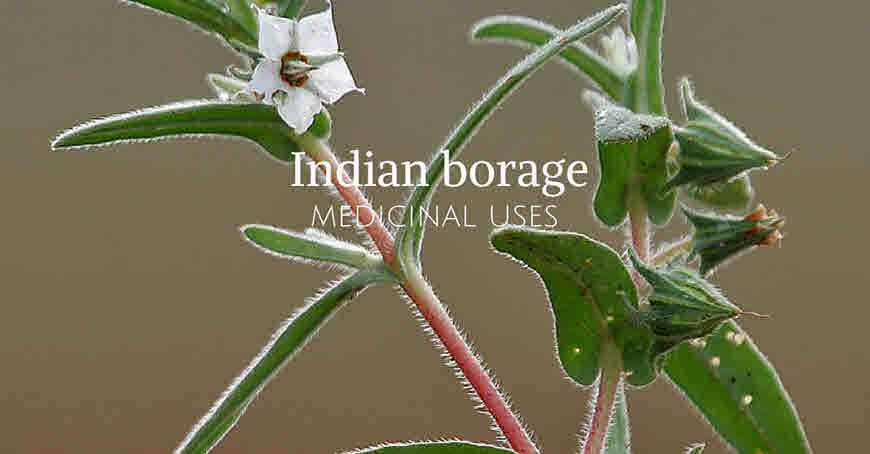Indian borage (Trichodesma indicum) or Andhahuli is medicinal plant that is found as a common weed throughout the India. It is an annual plant with pale blue flower. For the medicinal purpose, whole plant is used. In Ayurveda, leaves and roots of the plant are used to treat arthritis, anorexia, dysentery, skin diseases, poisoning and for wound healing. The paste of roots is applied on joint swelling.

Scientific study show the aerial parts of the plant have significant diuretic activity which may be useful in the treatment of acute pulmonary oedema, chronic heart failure, ascites, nephrotic syndrome, and renal failure.
General Information
The botanical name of Andhahuli/Indian borage is Trichodesma indicum R. Br. (=Borago indica). It belongs to plant family Boraginaceae.
Part(s) used for medicinal purpose: whole plant
Plant type: Annual prostrate herb/ common weed.
Distribution: Throughout India, along the dry wastelands, roadsides up to 1500 m.
Habitat: The greater part of India in the plains. Also found in Afghanistan, Pakistan, Philippines, Mauritius, and Africa.
Status: Common
Vernacular names
- Ayurvedic: Adah-pushpi, Adhomukha, Gandhapushpika, Andhaka, Andhpushpi अंधःपुष्पी, अन्धपुष्पी
- Siddha/Tamil: Kalhudaitumbai
- Folk: Andhahuli
- Hindi: Andhahuli, Chotta-kulpha अन्धाहुली, छोटा कुलफा
- Kannada: Athomukhi, Kattetumbesoppu
- Malyalam: Kilukkamtumpa
- Telugu: Guvvagutti
- Other common names: Handusi booti, Nila karaji
- English: Indian Borage
Plant Description
Annual herb. Stems 15-40 cm high, much branched, with spreading, not very dense hairs. Leaves sessile, oblong, lanceolate or lanceolate-oblong, lower leaves 5-8 by 0.8- cm, upper leaves 2-4.5 by 0.3-1.2 cm, base in lowermost leaves narrow, in the others broadly rounded, semiamplexicaulous, apex acute or obtusish, midrib distinct, sometimes also a few other nerves visible, hairs spreading-antrorse, arising from groups of mineralized cells on upper side, loose, crispulate on lower side. Inflorescences terminal on stem and branches, leafy, flowers axillary;pedicels 0.8-1.8 cm, curved downwards in fruit, with long, dense, spreading hairs. Calyx c. 1 cm long in flower, up to cm in fruit, cleft to the base into narrowly triangular, basally sagittate lobes 1.2 mm wide in flower, 2 mm wide in fruit, hairs loose, spreading from mineralized cells. Corolla funnel-shaped, lilac, tube c. 5 mm long, limb 1.3-1.5 cm in diam., lobes broadly rounded-acuminate, 7 mm long and wide. Nutlets oblong ovoid, 5 mm long, 2-3 mm wide, smooth, whitish. Pistil: style as long as calyx. Stamens: anthers oblong, sterile, twisted apex 4-5 mm long, densely woolly.
Constituents of Indian borage
The seeds gave linoleic, linolenic, oleic, palmitic and stearic acids. Hexacosane, ethylhexacosanoate, 21, 24-hexacosadienoic acid ethylester have been isolated from the leaves.
Medicinal Properties
The plant possess following medicinal properties. These properties are also supported by modern lab studies.
- Alexeteric: Counteracts an infection or toxin.
- Anodyne: Relieves pain without causing loss of consciousness.
- Antidote: Counteracts a poison
- Anti-dysenteric: Relieving or preventing dysentery.
- Anti-inflammatory: Reducing inflammation by acting on body mechanisms.
- Carminative: Preventing the formation or causing the expulsion of flatulence.
- Constipating: To cause constipation.
- Diuretic: Promoting excretion of urine/agent that increases the amount of urine excreted.
- Depurative: Purifying agent.
- Emollient: Soothing and softening effect on the skin or an irritated internal surface.
- Antipyretic/antifebrile/febrifuge: Effective against fever.
- Thermogenic: Heating
- Ophthalmic: Pertaining to the eye.
- Wound healing: Heals the wounds.
Medicinal uses of Andhahuli/Indian borage
- In Ayurvedic system of medicine, this plant is used in vitiated condition of Kapha/phlegm and Vata/wind.
- It is indicated in diarrheas, dysentery, joint swelling, eczema, and wounds.
- The leaves and roots of the plant are pounded and applied to swelling of joints and wounds two-three times a day for 3-4 days.
- For wounds, the paste of roots is applied externally.
REFERENCES
Periyanayagam JB, Sharma SK, Pillai KK. Evaluation of Antidiarrheal potential of Trichodesma indicum root extract in rats.
Srikanth K, Murugesan T, Anilkumar CH, Suba V, Das, AK, Sinha S, Arunachalam G, Manikandan . Effect of Trichodesma indicum extract on cough reflex induced by sulfur di oxide in mice. Phytomedicine 2002;Vol(1):75-77.
Periyanayagam JB, Sharma SK, Pillai KK. Anti-inflammatory activity of Trichodesma indicum. J Ethnopharmacol 2006;Vol. (104) 3(6):410-14.
Kirtikar KR., Basu BD. INDIAN MEDICINAL PLANTS, 2nd Edn, Vol.III, Lalit Mohan Basu Publisher: Allahabad:1672-1673, 1691-1695, (1975).
Chopra RN, Chopra IC, Handa KL, Kapur LD. Indigenous Drugs of India, U.N. Dhur & Sons Pvt. Ltd: Calcutta:528, (1958).